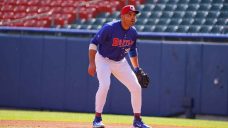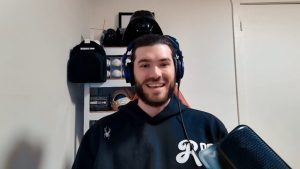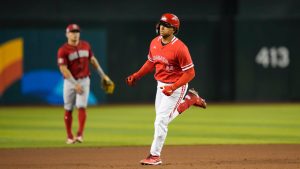With Vladimir Guerrero Jr. in the midst of a 20-game hitting streak, slashing .354/.407/.695 since the beginning of June, and due to hit the free agent market following the 2025 season, an extension for the slugger has become a hot topic in recent weeks.
Guerrero entered the season coming off an underwhelming 2023 and 2022 campaign that fell short of lofty expectations, making him a tough player to put a precise value on — but his 2024 has renewed confidence that he’s a middle-of-the-lineup force worth building around.
He’s a top-10 hitter in the majors by wRC+ (166) right now, and over the past four seasons combined (144). Players who fit that description are the kind of guys franchises tend to keep in town, even at great expense.
The Toronto Blue Jays are not ignorant to that reality, and appear open to the idea of making a meaningful effort to keep Vladdy in the fold. Coming together on an extension won’t necessarily be easy, though, and his position is a significant reason why.
Despite Guerrero’s sporadic work at third base this season (six games) and expressed willingness to move to the hot corner full-time if necessary, he is still primarily a first baseman — and MLB teams rarely make the kind of commitment he’ll demand from guys who play the game’s least-demanding defensive position.
There are just six first basemen on current contracts longer than three years, and two of them (Bryce Harper and Kris Bryant) were outfielders when they signed their deals. Jake Cronenworth also plays a significant amount of second base, leaving only three pure first basemen — Freddie Freeman, Paul Goldschmidt and Matt Olson — two of whom are credible Hall of Fame candidates.
Add Guerrero’s youth to his position and there simply aren’t many comparable contracts floating around out there.
The Boston Red Sox’s deal with Rafael Devers, a shaky defensive third baseman who may wind up at first at some point, ran 10 years, and $313.5 might be the best reference point available. At the time Devers signed his extension he’d accumulated 18.8 bWAR while Vladdy currently sits at 19.5. FanGraphs’ version at WAR sees a bigger gap between the two, though, with Devers at 21.3 pre-extension and Guerrero at 15.1 now.
Averaging those two Devers comes out as the more valuable player, but Guerrero is in the same ballpark and he has time to add to his totals by the end of this season. If the Blue Jays slugger signed an extension in the off-season he’d also be a year younger than Devers was when he locked in with the Red Sox.
While it’s reasonable to be skeptical about whether a player whose value is so offence-dependant can land a $300 million deal, it seems clear that if Vladdy lands a contract with double-digit term, he should be able to command a record-breaking contract for a first baseman, topping Miguel Cabrera’s $240 million deal from 2016.
Handing out an outlier deal at a position the rest of the league is reluctant to invest in is a scary proposition, but history can provide some guidance about how a Guerrero mega contract could age.
The term ‘some guidance’ is key here, as the first thing you notice when looking for historical comparables for Guerrero is there aren’t many. In the last 50 seasons, just one first baseman (Albert Pujols) has accumulated more plate appearances through his age-25 season than Vladdy — and he should catch up to future Hall of Famer by the end of the year.
Just 20 first basemen in that half-century managed at least 2,000 plate appearances before the beginning of their age-26 seasons rolled around. Guerrero ranks eighth on that list in career wRC+ (135), so we’ll take the seven players above him and below him on that list to form a comparable cohort.
The 14 players we’re left with include some significant names:
• Frank Thomas
• Albert Pujols
• Will Clark
• Don Mattingly
• Prince Fielder
• John Olerud
• Eddie Murray
• Freddie Freeman
• Anthony Rizzo
• Keith Hernandez
• Kent Hrbek
• Cody Bellinger
• Jason Thompson
• Rafael Palmeiro
Guerrero has not matched the top players on this list by early-career dominance — and you could quibble with Bellinger’s inclusion considering his time in the outfield — but his offence falls right in the middle of this group. So, the question becomes, if a team signed these players to decade-long contracts from age 26 on, how would it have gone for them?
In most cases, the answer is pretty well.
Almost all of the modern Guerrero comparables maintained significant offensive value in those years of their careers. Every single one had a wRC+ of 109 or better, with an average of 132 and only two falling short of 125. Those numbers could be altered slightly by Freeman, Rizzo, and Bellinger, but no one fell off a cliff.
In terms of pure value, the fWAR numbers are also solid as this group averaged 3.55 WAR per 600 plate appearances from age 26-35. Even if the Blue Jays ended up handing Guerrero a yearly salary around $30 million that type of production would be palatable.
All of that paints a rosy picture, but there are some cautionary tales in the bunch. Fielder and Thompson were done as major leaguers before their 33rd birthdays, and Mattingly’s three best offensive seasons came between the ages of 23 and 25. That said, Injuries played a significant role in those results, and they were anomalous in the group.
Even if we look at how these players performed from age 30 to 35, every single one (with the exception of Bellinger who isn’t 30 yet) had a wRC+ over 100, and the group averaged a solid 124.
None of this guarantees that a massive extension for Guerrero would work out well for the Blue Jays. It hints at it, but we’re talking about a small sample of first basemen who’ve started their careers in a similar fashion to the 25-year-old in recent decades.
Ultimately that’s the point. The fact that Guerrero lacks historical comparables suggests that he’s the kind of rare player who deserves a contract well outside the norm for his position.
A deal like that could backfire for the Blue Jays in the same way that any contract can fail to deliver value for a team — no matter how prudent it looks the day it’s signed. At the same time, talents like Guerrero don’t come around often, and when they do, they tend to produce for years and years.




 1:08
1:08
